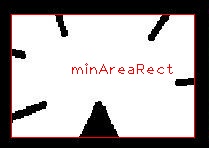This forum is disabled, please visit https://forum.opencv.org
 | 1 | initial version |
approxPolyDP can't do what you are looking for! check the doc or Douglas-Peucker algorithm
You can use convexHull 
vector<cv::Point> hull;
cv::convexHull(contours[i], hull);
//draw it
cv::polylines(im, hull, true, cv::Scalar(255, 0, 0));
or approx it a bit more 
double len = arcLength(hull, true);
double epsilon = 0.02*len;
vector<cv::Point> approx;
cv::approxPolyDP(hull, approx, epsilon, true);
cv::polylines(im, approx, true, cv::Scalar(0, 255, 0));
Or minAreaRect 
cv::RotatedRect rr;
rr = cv::minAreaRect(contours[i]);
//draw the rectangle
cv::Point2f rect_points[4];
rr.points(rect_points);
for (int j = 0; j < 4; j++)
cv::line(im, rect_points[j], rect_points[(j + 1) % 4], cv::Scalar(0, 0, 255), 2, 8);
OR look at find square example: https://github.com/Itseez/opencv/blob/master/samples/python2/squares.py
 | 2 | No.2 Revision |
approxPolyDP can't do what you are looking for! for becase you have to find right epsilon that cuts just "defects", check the doc or Douglas-Peucker algorithm
You can use convexHull 
vector<cv::Point> hull;
cv::convexHull(contours[i], hull);
//draw it
cv::polylines(im, hull, true, cv::Scalar(255, 0, 0));
or approx it a bit more 
double len = arcLength(hull, true);
double epsilon = 0.02*len;
vector<cv::Point> approx;
cv::approxPolyDP(hull, approx, epsilon, true);
cv::polylines(im, approx, true, cv::Scalar(0, 255, 0));
Or minAreaRect 
cv::RotatedRect rr;
rr = cv::minAreaRect(contours[i]);
//draw the rectangle
cv::Point2f rect_points[4];
rr.points(rect_points);
for (int j = 0; j < 4; j++)
cv::line(im, rect_points[j], rect_points[(j + 1) % 4], cv::Scalar(0, 0, 255), 2, 8);
OR look at find square example: https://github.com/Itseez/opencv/blob/master/samples/python2/squares.py